List of German inventions and discoveries
The following list is composed of items, techniques and processes that were invented by or discovered by people from Germany or German-speaking Europe.
Anatomy
- Discovery of the Ampulla of Vater by Abraham Vater in 1720.[1]
- First description of Auerbach's plexus by Leopold Auerbach (19th century).
- First description of Brodmann's areas by Korbinian Brodmann in 1909.[2]
- First description of Crypts of Lieberkühn by Johann Nathanael Lieberkühn in 1745.
- First description of Duct of Wirsung by Johann Georg Wirsung.
- First description of Meissner's plexus and Tactile corpuscle by Georg Meissner.
- First description of Merkel cell by Friedrich Sigmund Merkel
- Discovery of the Alzheimer disease by Alois Alzheimer in 1906
- Discovery of Langerhans cell and Islets of Langerhans by Paul Langerhans
- Discovery of Schwann cells in the peripheral nervous system by Theodor Schwann
- Discovery and study of pepsin by Theodor Schwann
Archaeology

Troy
- Troy by Heinrich Schliemann
- Hattusa by Hugo Winckler
- Deciphering of cuneiform by Georg Friedrich Grotefend
- Gordium by Gustav Körte and Alfred Körte
Arts
Astronomy

Illustration of Kepler's second law

Neptune
- Cosmic ray by Theodor Wulf and Victor Hess
- Kepler's laws of planetary motion by Johannes Kepler
- Schwarzschild metric and Schwarzschild radius by Karl Schwarzschild
- Neptune by Johann Galle
- Uranus, with two of its major moons, (Titania and Oberon), by the British-German William Herschel
Biology and genetics
- Cell theory by Theodor Schwann, Matthias Jakob Schleiden and Rudolf Virchow
- Isolated the non-protein component of "nuclein", nucleic acid, and later isolated its five primary nucleobases by Albrecht Kossel
- Chromatography by Friedlieb Ferdinand Runge
- Humboldt penguin by Franz Meyen
- Humboldtian science by Alexander von Humboldt
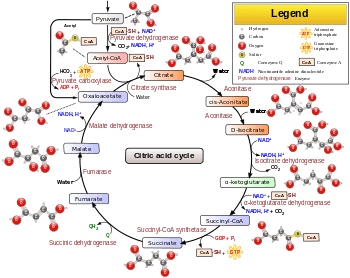
Overview of the citric acid cycle (click to enlarge)
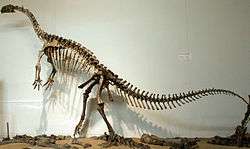
Plateosaurus Skelett
- Plateosaurus by Christian Erich Hermann von Meyer
- Rhamphorhynchus by Christian Erich Hermann von Meyer
- Archaeopteryx by Christian Erich Hermann von Meyer
- Teratosaurus by Christian Erich Hermann von Meyer
- Aegyptosaurus by Ernst Stromer
- Bahariasaurus by Ernst Stromer
- Carcharodontosaurus by Ernst Stromer
- Spinosaurus aegyptiacus, the largest known theropod, by Ernst Stromer
- Giant crocodilian Stomatosuchus by Ernst Stromer
- Alternation of generations by Wilhelm Hofmeister
- Mesonephros by Caspar Friedrich Wolff
.jpg)
A reconstruction of Homo heidelbergensis.
- Homo heidelbergensis by Otto Schoetensack
- Neanderthal by Johann Carl Fuhlrott
- Recapitulation theory by Ernst Haeckel
- Weismann barrier by August Weismann
- Germ plasm by August Weismann
- Hardy–Weinberg principle by Wilhelm Weinberg
- Centrosome by Theodor Boveri
- determining the chemical composition of nucleic acids by Albrecht Kossel

Events involving meiosis, showing chromosomal crossover
- Meiosis by Oscar Hertwig.
- Mitosis by Hugo von Mohl
- Mitochondrion by Richard Altmann, 1894
Chemistry
- Glauber's salt by Johann Rudolf Glauber (German-Dutch alchemist and chemist) in 1625.
- Eupione by Carl Reichenbach.
- Paraffin wax was identified by Carl Reichenbach in 1830.[3]
- Caesium by Robert Bunsen and Gustav Kirchhoff
- Rubidium by Robert Bunsen and Gustav Kirchhoff
- Protactinium by Otto Hahn and Lise Meitner
- Indium by Ferdinand Reich and Hieronymous Theodor Richter in 1863-1864.[4][5][6]
- Germanium by Clemens Winkler in 1886.[7]
- Bohrium at the GSI Helmholtz Centre for Heavy Ion Research between 1981 and 1996.[8]
- Meitnerium at the GSI Helmholtz Centre for Heavy Ion Research on August 29, 1982.[9]
- Hassium at the GSI Helmholtz Centre for Heavy Ion Research in 1984.[10]
- Darmstadtium by Peter Armbruster and Gottfried Münzenberg, under the direction of professor Sigurd Hofmann, on November 9, 1994, at the GSI Helmholtz Centre for Heavy Ion Research in Darmstadt.[11]
- Roentgenium at the GSI Helmholtz Centre for Heavy Ion Research on December 8, 1994.[12]
- element Uranium, dicsovered by Martin Heinrich Klaproth
- Zirconium by Martin Heinrich Klaproth
- Oxygen (although Joseph Priestley published his findings first) by Carl Wilhelm Scheele
- Identification of molybdenum, tungsten, barium, hydrogen and chlorine by Carl Wilhelm Scheele
- Phenol [13]
- Pittacal
- Opioids including morphine,[14] methadone,[15] oxycodone,[16] hydrocodone,[17] hydromorphone,[18] oxymorphone,[19] nicomorphine,[20] desomorphine, dihydrocodeine, dipropanoylmorphine, hydromorphinol, heterocodeine, and a number of others.
- Cocaine[21]
- Amphetamines[22]
- Barbiturates[23]
- Methadone by Max Bockmühl and Gustav Ehrhart (IG Farben)
- Urea by Friedrich Wöhler in 1828
- Claus process by the chemist Carl Friedrich Claus, 1883
- Haber process by Fritz Haber and Carl Bosch
- Paal–Knorr synthesis by Carl Paal and Ludwig Knorr
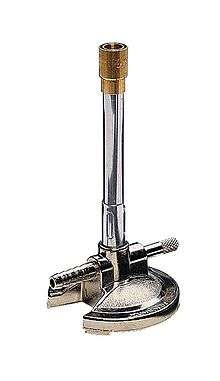
Bunsen burner
- Bunsen burner by Robert Bunsen
- Pinacol coupling reaction by Wilhelm Rudolph Fittig
- Ostwald process by Wilhelm Ostwald
- Diels–Alder reaction by Otto Diels and Kurt Alder
- Wittig reaction by Georg Wittig
- Coal liquefaction by Friedrich Bergius
- Büchner flask and Büchner funnel[24]
- Erlenmeyer flask
- Petri dish [25]
- Schlenk flask [26]
- Prussian blue by Heinrich Diesbach[27]
- Zyklon B by Walter Heerdt, Bruno Tesch, others, at Degesch [28]
- Siemens cycle
- Ziegler–Natta catalyst by Karl Ziegler and Natta
- Styrene-butadiene (synthetic rubber) by Walter Bock
- Galalith by Wilhelm Krische
- Poly(methyl methacrylate) by Wilhelm Rudolph Fittig, 1877
- Polycarbonate by Alfred Einhorn, 1898
- Polyvinyl chloride by Eugen Baumann, 1872
- Polyethylene by Hans von Pechmann, 1898
- Polyurethane, by Otto Bayer, 1937
- Hampson–Linde cycle by Carl von Linde, 1895
Clothing and fashion
- Permanent wave by German born Karl Nessler
- Lederhosen
- Dirndl
- Tracht and Gamsbart
Computing
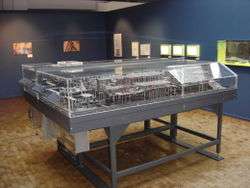
Replica of the Z1 in the German Museum of Technology in Berlin
- computer by Konrad Zuse
- Plankalkül by Konrad Zuse
- modern Binary numeral system [29]
- MP3 by Karlheinz Brandenburg (with contributions from many other people) in the late 1980s and early 1990s.[30]
- smart card by Jürgen Dethloff and Helmut Gröttrup
Construction and architecture

Drill scheme
- electrically-driven hand drill by Wilhelm Emil Fein
- Wire rope by Wilhelm Albert[31][32][33]
- Breaker (hydraulic)
- portable electric and petrol chainsaw
- angle grinder
Cuisine

A glass of Berliner Weisse flavoured with raspberry syrup

Currywurst
- Currywurst by Herta Heuwer
- Donauwelle
- Fanta
- Frankfurter Kranz
- Frankfurter Würstchen
- Gummy bear
- Hedgehog slice (Kalter Hund)
- Lebkuchen
- Meat extract by Justus von Liebig
- Obatzda
- Parboiled rice (Huzenlaub Process) by Erich Gustav Huzenlaub
- Pinkel
- Pretzel
- Prinzregententorte
- Pumpernickel
Pfälzer Saumagen

Toast Hawaii
Education and printing
- Printing with movable type, by Johannes Gutenberg
- Kindergarten by Friedrich Fröbel
- Grimms' Fairy Tales by Jacob Grimm and Wilhelm Grimm
- Lithography by Alois Senefelder
- recyclable paper and deinking by Justus Claproth
Entertainment and media
- PAL, short for Phase Alternating Line, is a colour encoding system for analogue television by Walter Bruch, Telefunken
- Oscilloscope and cathode ray tube by Ferdinand Braun
- Nipkow disk by Paul Gottlieb Nipkow
- Short Message Service
- MP3
Geology and mining
- Mohs scale of mineral hardness by Friedrich Mohs in 1812 (one of several definitions of hardness in materials science).[34]
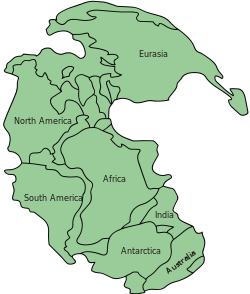
Map of Pangaea with modern continents outlined
- Theory of continental drift (presented in 1912) and postulation of the existence of Pangaea by Alfred Wegener
Household and office appliance
- Paper Coffee filter[35]
- Wigomat, the first Electrical drip coffee maker patented in 1954[36]
Two-hole (filebinder) hole punch
- Hole punch by Friedrich Soennecken
- Ring binder by Friedrich Soennecken
- Glue stick by company Henkel
- Ink eraser by company Pelikan
- Adhesive tape by company Beiersdorfer
- Ingrain wallpaper by Hugo Erfurt
Mathematics

Regional variations (English, German, Russian) of the integral symbol.
- Integral symbol by Gottfried Wilhelm Leibniz
- Leibniz's notation by Gottfried Wilhelm Leibniz
- Leibniz formula for π by Gottfried Wilhelm Leibniz
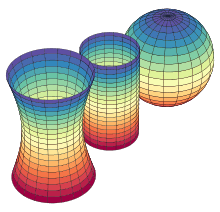
surfaces of Gaussian curvature.
- Gaussian curvature by Carl Friedrich Gauss
- Gauss map by Carl Friedrich Gauss
- Gaussian elimination by Carl Friedrich Gauss
- Cantor–Bernstein–Schroeder theorem
- Cantor's theorem by Georg Cantor
- Cantor's first uncountability proof by Georg Cantor
- Cantor's diagonal argument by Georg Cantor
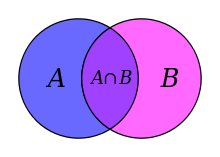
Illustration the intersection of two sets.
Medicine
- Alzheimer's disease by Alois Alzheimer
- Morphine [37]
- Prontosil by Gerhard Domagk
- Aspirin by Felix Hoffmann and Arthur Eichengrün
- Adhesive bandage by Paul Carl Beiersdorf
- Eucerit and Labello
- Pressure-sensitive tape by company Beiersdorf
- Cardiac catheterization by Werner Forssmann
- X-ray tube
- tubercle bacillus by Robert Koch
- Vibrio cholerae by Robert Koch
- Koch's postulates by Robert Koch
- microscopic pathology by Rudolf Virchow
- diphtheria antitoxin by Emil Adolf von Behring
- Luria–Delbrück experiment by Max Delbrück (together with Luria)
- Arsphenamine by Paul Ehrlich (together with Hata)
- Intramedullary rod by Gerhard Küntscher
- Alcohol thermometer by Daniel Gabriel Fahrenheit
- Homeopathy, conceived by Samuel Hahnemann
- Electroencephalography for humans, by Hans Berger, 1924. Berger discovered Alpha waves[38]
- Discovery and description of Graves-Basedow disease by Karl Adolph von Basedow (also Graves)
- Chain Osteotome by Bernhard Heine
- Glass Contact lenses by Adolf Gaston Eugen Fick
- Discovery of the organism causing diphtheria (Corynebacterium diphtheriae), Löffler's medium and the cause of Foot-and-mouth disease (Aphthovirus) by Friedrich Loeffler.
Military
- The modern flamethrower by Richard Fiedler in 1901.[39]
- Submachine gun (MP 18 by Theodor Bergmann)
- The modern assault rifle

Replica of V2
- Cruise missile : V-1 flying bomb
- Ballistic missile : A-4,[40] known as the V-2 rocket in the 1940s under direction of Wernher von Braun.
- Rifling [41]
- Dreyse needle gun by Johann Nicolaus von Dreyse
- Rocket-powered aircraft, the Lippisch Ente in 1928.[42]
- Mass-produced rocket-powered aircraft, the Messerschmitt Me 163 in 1944[43]
- Brandtaucher by Wilhelm Bauer
- Ani-tank missile
- Anti-tank grenade
- Anti-tank rifle: Mauser 1918 T-Gewehr
Musical instruments
- Wagner tuba by Richard Wagner in the 1850s (inspired by Adolphe Sax).[44]
- Accordion[45]
- Bandoneon by Heinrich Band[46]
- Glockenspiel, invented either in Germany (then part of the Holy Roman Empire) or in the County of Hainaut (now Belgium) in the 18th century.
- Gramophone record by Emil Berliner
- Clarinet by Johann Christoph Denner
- Harmonica by Christian Friedrich Ludwig Buschmann
Physics
- first telephone transmitter in 1861 by Johann Philipp Reis, he also invented the term telephone.
- Deinking by Justus Claproth
- Geissler tube by Heinrich Geißler
- Planck constant by Max Planck
- Planck's law by Max Planck
- Refractometer by Ernst Abbe in 1874.[47]
- Scanning tunneling microscope by Gerd Binnig (German) and Heinrich Rohrer (Swiss) (at IBM Zürich) .[48][49]
- Stark effect by Johannes Stark
- Stark spectroscopy by Johannes Stark
- Electron microscope
- Nuclear isomerism by Otto Hahn
- Nuclear fission by Otto Hahn and Fritz Straßmann
- Geiger–Müller tube by Hans Geiger and Walther Müller

Geiger-Müller Counter
4-meter-tall sculpture of Einstein's 1905 E = mc2 formula at the 2006 Walk of Ideas, Berlin, Germany.
- Mass–energy equivalence by Albert Einstein
- General relativity by Albert Einstein
- Special relativity by Albert Einstein
- Bose–Einstein statistics, Bose–Einstein condensate and Boson by Albert Einstein (together with Bose)

X-rays are part of the electromagnetic spectrum, with wavelengths shorter than visible light. Different applications use different parts of the X-ray spectrum.
- x-ray by Wilhelm Röntgen
- Noether's theorem by Emmy Noether
- Nuclear shell model by Maria Goeppert-Mayer and J. Hans D. Jensen
- Quantum Hall effect by Klaus von Klitzing
- Giant magnetoresistance by Peter Grünberg (together with Albert Fert)
- Anode ray by Eugen Goldstein
- Ohm's law by Georg Ohm
- vacuum pump and Magdeburg hemispheres by Otto von Guericke
- Radio waves and Electromagnetic radiation by Heinrich Hertz
- Nernst lamp by Walther Nernst
- Wien approximation and Wien's displacement law by Wilhelm Wien
- Ultraviolet by Johann Wilhelm Ritter
- electromagnetic and radio waves, discovered by Heinrich Hertz
- Barkhausen effect and Barkhausen stability criterion by Heinrich Barkhausen
- Echo sounding by Alexander Behm. The patent was granted in 1913.[50][51]
- Betz's law by Albert Betz, 1913[52]
Sociology, philosophy and politics
- Marxism by Karl Marx and Friedrich Engels
- Philosophy of Friedrich Nietzsche by Friedrich Nietsche
- Verstehen by Max Weber
- Critical theory and Frankfurter School
- (Health insurance), 1883: Krankenversicherung
- Accident insurance, 1884 Unfallversicherung
- Pension insurance, Gesetzliche Rentenversicherung, 1889
Religion and ethics
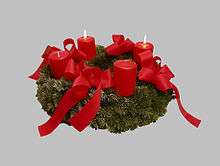
Wreath with two candles lit for the second Sunday of Advent

Easterbunny
- Easter Bunny
- Protestantism and Lutheranism : in 1517, Martin Luther, an Augustinian priest, published The Ninety-Five Theses.[53]
- Plastination by Gunther von Hagens
- Kantianism by Immanuel Kant
- German idealism
Science
- Bark scale by Eberhard Zwicker in 1961. It is named after Heinrich Barkhausen.
- Bergius process by Friedrich Bergius in 1913.[54][55]
- Richter magnitude scale by Beno Gutenberg (together with Charles Francis Richter)
- Fahrenheit, temperature scale by Daniel Gabriel Fahrenheit
Scientific instruments
- Stauroscope by Wolfgang Franz von Kobell in 1855.[56]
- laboratory refractometer, the Abbe refractometer by Ernst Abbe
- Metal detector by Fischer
- Fahrenheit hydrometer by Daniel Gabriel Fahrenheit
- Abbe refractometer by Ernst Abbe [57]
Spaceflight
Sport
- Elfmeter in football by Karl Wald
- modern football boots with screw-in studs by Adolf Dassler
- horizontal bar and Parallel bars by Friedrich Ludwig Jahn
- Wheel gymnastics by Otto Feick
Tourism and recreation
- Strandkorb
- Carabiner for climbing by Otto Herzog [58]
- cruise ship by Albert Ballin (cruise ship Prinzessin Victoria Luise)
Toys
- Playmobil
- first home video console Magnavox Odyssey
- Mensch ärgere dich nicht game board
- Skat, Doppelkopf and Schafkopf, card game

The fischertechnik
- Fischertechnik
- The Settlers of Catan
- Plastilin, patented by Franz Kolb, 1880
Transportation
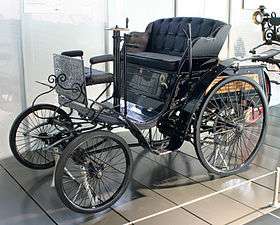
automobile Benz Velo
- Modern automobile (gasoline engine) by Karl Benz in 1885.[59]
- Motorcycle by Gottlieb Daimler and Wilhelm Maybach (Daimler Reitwagen in 1885)
- Helicopter the first operational and practical helicopter was the Focke-Wulf Fw 61 developed the Focke-Achgelis company.
- Internal combustion engine buses
- first electric passenger train by Siemens
- first regular electric tram service using pantographs or trolley poles, the Gross-Lichterfelde Tramway by Siemens
- first aircraft with a turbojet by Hans von Ohain
- Otto engine by Nicolaus Otto
- Diesel engine by Rudolf Diesel
- Wankel engine by Felix Wankel
- Modern truck in 1896 by Gottlieb Daimler
- Zeppelin (a type of rigid airship) by Ferdinand von Zeppelin in 1893.[60]
- Rocket-powered aircraft by Fritz Stamer in 1928.
- Air bag by Walter Linderer
- World's first practical all-metal aircraft: Junkers J 1
- Jerrycan
- Gyrocompass by Hermann Anschütz-Kaempfe
- Defogger by Heinz Kunert
- Krueger flap by Werner Krüger
- Taximeter by Friedrich Wilhelm Gustav Bruhn[61]
- Tachometer by Diedrich Uhlhorn
- Spoiler
- Filling station
- Carburetor
- Diesel fuel
- Biodiesel
- Gasoline
See also
References
- ↑ Dissertatio anatomica quo novum bilis dicetilicum circa orifucum ductus choledochi ut et valvulosam colli vesicæ felleæ constructionem ad disceptandum proponit, 1720
- ↑ Brodmann K. Vergleichende Lokalisationslehre der Grosshirnrinde. Leipzig : Johann Ambrosius Bart, 1909
- ↑ Britannica (1911)
- ↑ Venetskii, S. (1971). "Indium". Metallurgist 15 (2): 148–150. doi:10.1007/BF01088126.
- ↑ Reich, F.; Richter, T. (1864). "Ueber das Indium". Journal für Praktische Chemie (in German) 92 (1): 480–485. doi:10.1002/prac.18640920180.
- ↑ Schwarz-Schampera, Ulrich; Herzig, Peter M. (2002). Indium: Geology, Mineralogy, and Economics. Springer. ISBN 978-3-540-43135-0.
- ↑ Winkler, Clemens (1887). "Germanium, Ge, a New Nonmetal Element" (English translation). Berichte der deutschen chemischen Gesellschaft (in German) 19 (1): 210–211. doi:10.1002/cber.18860190156.
- ↑ WebElements.com – Bohrium
- ↑ Münzenberg, G.; Armbruster, P.; Heßberger, F. P.; Hofmann, S.; Poppensieker, K.; Reisdorf, W.; Schneider, J. H. R.; Schneider, W. F. W.; et al. (1982). "Observation of one correlated α-decay in the reaction 58Fe on 209Bi→267109". Zeitschrift für Physik A 309 (1): 89. Bibcode:1982ZPhyA.309...89M. doi:10.1007/BF01420157.
- ↑ Barber, R. C.; Greenwood, N. N.; Hrynkiewicz, A. Z.; Jeannin, Y. P.; Lefort, M.; Sakai, M.; Ulehla, I.; Wapstra, A. P.; Wilkinson, D. H. (1993). "Discovery of the transfermium elements. Part II: Introduction to discovery profiles. Part III: Discovery profiles of the transfermium elements (Note: for Part I see Pure Appl. Chem., Vol. 63, No. 6, pp. 879-886, 1991)". Pure and Applied Chemistry 65 (8): 1757. doi:10.1351/pac199365081757.
- ↑ Karol, P. J.; Nakahara, H.; Petley, B. W.; Vogt, E. (2001). "On the discovery of the elements 110-112 (IUPAC Technical Report)". Pure and Applied Chemistry 73 (6): 959. doi:10.1351/pac200173060959.
- ↑ Hofmann, S.; Ninov, V.; Heßberger, F. P.; Armbruster, P.; Folger, H.; Münzenberg, G.; Schött, H. J.; Popeko, A. G.; et al. (1995). "The new element 111". Zeitschrift für Physik A 350 (4): 281. Bibcode:1995ZPhyA.350..281H. doi:10.1007/BF01291182.
- ↑ F. F. Runge (1834) "Ueber einige Produkte der Steinkohlendestillation" (On some products of coal distillation), Annalen der Physik und Chemie, 31 : 65-78. On page 69 of volume 31, Runge names phenol "Karbolsäure" (coal-oil-acid, carbolic acid). Runge characterizes phenol in: F. F. Runge (1834) "Ueber einige Produkte der Steinkohlendestillation," Annalen der Physik und Chemie, 32 : 308-328.
- ↑ Andreas Luch (2009). Molecular, clinical and environmental toxicology. Springer. p. 20. ISBN 3-7643-8335-6.
- ↑ M. Bockmuhl, Über eine neue Klasse von analgetisch wirkenden Verbindungen Ann. Chem. 561, 52 (1948)
- ↑ German (DE) Patent 296916
- ↑ Mannich, C.; Löwenheim, H. (1920). "Ueber zwei neue Reduktionsprodukte des Kodeins". Archiv der Pharmazie 258 (2–4): 295–316. doi:10.1002/ardp.19202580218.
- ↑ Felden, L.; C. Walter; S. Harder; R.-D. Treede; H. Kayser; D. Drover; G. Geisslinger; J. Lötsch (22 September 2011). "Comparative Clinical Effects of Hydromorphone and Morphine". British Journal of Anaesthesia 107 (3): 319–328. doi:10.1093/bja/aer232. PMID 21841049. Retrieved 10 March 2012.
- ↑ Sinatra, Raymond (2010). The Essence of Analgesia and Analgesics. MA, USA: Cambridge University Press; 1 edition. p. 123. ISBN 978-0-521-14450-6.
- ↑ Nicotinates: Nicomorphine, Nicocodeine, Etofibrate, Nicodicodeine, Ronifibrate, Aluminium Nicotinate, Morniflumate, Xantinol Nicotinate. LLC Books. 2010. p. 30. ISBN 978-1-157-22061-9.
- ↑ F. Gaedcke (1855). "Ueber das Erythroxylin, dargestellt aus den Blättern des in Südamerika cultivirten Strauches Erythroxylon Coca". Archiv der Pharmazie 132 (2): 141–150. doi:10.1002/ardp.18551320208.
- ↑ Edeleano L (1887). "Ueber einige Derivate der Phenylmethacrylsäure und der Phenylisobuttersäure". Berichte der deutschen chemischen Gesellschaft 20 (1): 616–622. doi:10.1002/cber.188702001142.
- ↑ "Barbiturates". Retrieved 2007-10-31.
- ↑ Jensen, William B. (September 2006). "The Origins of the Hirsch and Büchner Vacuum Filtration Funnels" (PDF). Journal of Chemical Education 83 (9): 1283. Bibcode:2006JChEd..83.1283J. doi:10.1021/ed083p1283.
- ↑ Yahoo Education:Petri dish
- ↑ Royal Society of Chemistry :Classic Kit: Schlenk apparatus
- ↑ Jens Bartoll. "The early use of prussian blue in paintings" (PDF). 9th International Conference on NDT of Art, Jerusalem Israel, 25–30 May 2008. Retrieved 2010-01-22.
- ↑ Van Husen, William H. "Zyklon B". World War II in Europe: An Encyclopedia(1999) p. 1153.
- ↑ Leibniz G., Explication de l'Arithmétique Binaire, Die Mathematische Schriften, ed. C. Gerhardt, Berlin 1879, vol.7, p.223; Engl. transl.
- ↑ Ewing, Jack (5 March 2007). "How MP3 Was Born". BusinessWeek. Retrieved 24 July 2007.
- ↑ "Wilhelm Albert". Encyclopædia Britannica. Retrieved 9 April 2014.
- ↑ Koetsier,Teun ; Ceccarelli, Marc (2012). Explorations in the History of Machines and Mechanisms. Springer Publishing. p. 388. Retrieved 9 April 2014.
- ↑ Donald Sayenga. "Modern History of Wire Rope". History of the Atlantic Cable & Submarine Telegraphy (atlantic-cable.com). Retrieved 9 April 2014.
- ↑ Encyclopædia Britannica. 2009. Encyclopædia Britannica Online. 22 Feb. 2009 "Mohs hardness."
- ↑ The History of Coffee
- ↑ "Sixty years of the Federal Republic of Germany – a retrospective of everyday life". Retrieved 28 December 2012.
- ↑ Morphine Discovery
- ↑ Berger's invention has been described "as one of the most surprising, remarkable, and momentous developments in the history of clinical neurology." David Millet (2002), "The Origins of EEG" International Society for the History of the Neurosciences (ISHN)
- ↑ First World War, Willmott, H.P., Dorling Kindersley, 2003, Page 106
- ↑ Zaloga, Steven (2003). V-2 Ballistic Missile 1942-52. Reading: Osprey Publishing. p. 3. ISBN 978-1-84176-541-9.
- ↑ W. S. Curtis. "Long Range Shooting: A Historical Perspective".
- ↑ Darling, David. "Lippisch Ente", The Internet Encyclopedia of Science – Experimental Aircraft. Accessed 5 October 2008.
- ↑ "Me-163 Komet". Planes of Fame Air Museum. Accessed 5 October 2008.
- ↑ John Humphries, The Early Horn (Cambridge: Cambridge UP, 2000), p. 41.
- ↑ Doktorski, Henry. "Interview With Fredrik Dillner - The Owner Of What May Be The World's Oldest Accordion". The Free-Reed Journal : Articles and Essays Featuring Classical Free-Reed Instruments and Performers. Ksanti. Retrieved 14 February 2012.
- ↑ Randel, Don Michael (2003). The Harvard Dictionary of Music. Harvard University Press. p. 978.
- ↑ Sella, Andrea (November 2008). "Abbé's refractometer". Chemistry World: 67.
- ↑ Binnig, G.; Rohrer, H. (1986). "Scanning tunneling microscopy". IBM Journal of Research and Development 30 (4): 355–69.
- ↑ Press release for the 1986 Nobel Prize in physics
- ↑ Salous, Sana (2013). Radio Propagation Measurement and Channel Modelling. John Wiley & Sons. p. 424.
- ↑ Xu, Guochang (2010). Sciences of Geodesy - I: Advances and Future Directions. Springer Publishing. p. 281.
- ↑ Betz, A. (1966) Introduction to the Theory of Flow Machines. (D. G. Randall, Trans.) Oxford: Pergamon Press.
- ↑ "Martin Luther 95 Theses". Uncommon-travel-germany.com. Retrieved 2010-11-19.
- ↑ Bergius, Friedrich (May 21, 1932). "Chemical reactions under high pressure" (PDF). Nobel Foundation. Retrieved 2012-02-29.
- ↑ D. Valentin: Kohleverflüssigung - Chancen und Grenzen, Praxis der Naturwissenschaften, 1/58 (2009), S. 17-19.
- ↑ http://en.wikisource.org/wiki/1911_Encyclop%C3%A6dia_Britannica/Kobell,_Wolfgang_Xaver_Franz,_Baron_von
- ↑ Museum of optical instruments:Abbe-Refraktometer, Carl Zeiss Jena
- ↑ "A History of the Carabiner". Mountain Spirit Institute. Retrieved 2013-01-07.
- ↑ Ralph Stein (1967). The Automobile Book. Paul Hamlyn Ltd.
- ↑ Dooley, Sean C., The Development of Material-Adapted Structural Form – Part II: Appendices. THÈSE NO 2986 (2004), École Polytechnique Fédérale de Lausanne
- ↑ Depatisnet:Bibliographische Daten (Deutsches Patent und Markenamt):Taximeter (German)
| ||||||||||||||
This article is issued from Wikipedia - version of the Monday, February 08, 2016. The text is available under the Creative Commons Attribution/Share Alike but additional terms may apply for the media files.
